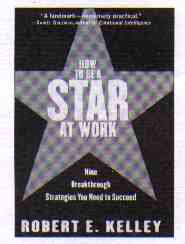How To Be A Star At Work
by Robert E. Kelly, Times Business, Random House, New York, 1999.
I don’t like small print and although I am a
great believer in the power of telling stories, I get tired of real
live case studies, one after another. That said this is a solidly
researched book that presents important ideas in a straightforward
and comprehensive manner. You may not always agree with some of the
points, but if you bear with the book (and read it all – don’t
skip) everything will hang together.
 Remember,
this book is about strategies – not a how to. For example,
strategy eight, "Organizational Savvy" goes on to list a
number of skill sets. One of these is managing conflict. This skill
is awarded three pages in the book, but as we all know is a complex
competency.
Remember,
this book is about strategies – not a how to. For example,
strategy eight, "Organizational Savvy" goes on to list a
number of skill sets. One of these is managing conflict. This skill
is awarded three pages in the book, but as we all know is a complex
competency.
There is no right way for each and every one of
us. I appreciated how differences and individual personalities are
validated and reinforced in the book. Nor does the author downplay
the potential pitfalls or possible negative consequences for
adopting a strategy. Each one has its own risks.
I found two of the strategies presented
particularly interesting. The first star performer strategy is
initiative. "Initiative is the most widely misunderstood of all
the star performer work strategies". The clarification between what
is initiative versus what is just doing your job
is an important concept for individuals to understand. The
difference is well laid out in the material. Chapter 6 provides an
insightful presentation on networking. In my experience, I find that
individuals often misunderstand the importance of networking and
what it really is. I am sure that each reader will find a particular
chapter or two speaks to him or her.
Kelly states in his preface that "you should
resist skipping around to chapters that seem more interesting…
start at the beginning with the model and read through the work
strategy chapter in the order presented." I suggest a couple of
caveats. I skimmed the appendix first. I wanted to get a sense of
the research behind the book. There on page 305 is a very important
table. It is a list of seven factors that Kelly has discovered that
create the perception or judgment by superiors that an individual
shows high productivity and performance. After all aren’t these
strategies and underlying skill sets on how to be a star all about
being perceived as one by others?
Read chapter 14 on "Becoming a Star
Performer" either after chapter two or four. I thought that
this section provided some perspective to the book as a whole. It is
short so you can reread it again when you come to it. I liked
chapter 4 which responses to questions from interested readers and
motivated me to read on. It did sound a little like a sales pitch at
times.
Which brings me to my last beef. Kelly stresses
that this book is based on lengthy and extensive research,
particularly at Bell Labs and I acknowledge the contribution that he
has made. Kelly and his group, Consultant to Executives and
Organizations Ltd. have developed a program based on his model. This
too has been researched and evaluated for its effectiveness that
appears impressive. Unfortunately, I often got the impression that
the book is a ruse for selling this training package. That is
unfortunate. The book stands alone on its own merits as having
something important to say to individuals who want to improve their
organizational impact.
 RFH
(99/08)
RFH
(99/08)
For
more information

